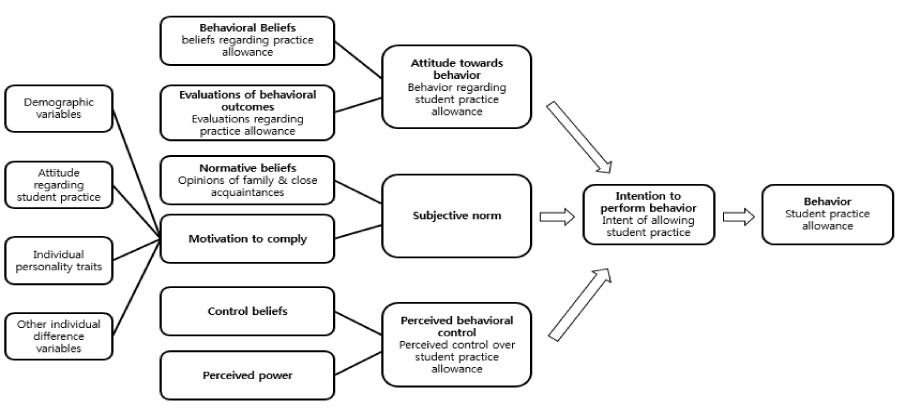Perspect Nurs Sci.
2017 Apr;14(1):10-20. 10.16952/pns.2017.14.1.10.
Opinions and Perceptions on Allowing Nursing Students' Practice among Inpatients at a University Hospital
- Affiliations
-
- 1RN, Asan Medical Center, Seoul, Korea.
- 2RN, Seoul National University Hospital, Seoul, Korea.
- 3RN, Samsung Medical Center, Seoul, Korea.
- 4Undergraduate Student, College of Nursing, Seoul National University, Seoul, Korea.
- 5Undergraduate, College of Nursing, Seoul National University, Seoul, Korea.
- 6Head Nurse, Seoul National University Hospital, Seoul, Korea.
- 7Professor, College of Nursing, Seoul National University, Seoul, Korea. kim0424@snu.ac.kr
- KMID: 2377963
- DOI: http://doi.org/10.16952/pns.2017.14.1.10
Abstract
- PURPOSE
The aim of this study was to explore the patients' perspectives on nursing students' clinical practices in the wards, and to investigate their willingness for allowing students to practice on them.
METHODS
This was a descriptive study. 116 inpatients were recruited from the S University Hospital. A 60-item questionnaire was applied to collect the data. The participants were 19 years and older with sound judgement, and were not in special or intensive care units. Data analysis was done in SPSS/WIN 22.0 using descriptive statistics, Fishers exact test, and the ANOVA test. the participant answered to questionnaire from April 29th 2016 to May 10th.
RESULTS
40 participants (34.5%) stated they would allow students' practice, while 72 (61.2%) said they would allow only under staff supervision. 5 participants (4.3%) stated they would not allow whatsoever. The 3 most allowed were emotional support, oral care, and vital signs measurement while the 3 least allowed were gastric feeding, intravenous catheterization, and urinary catheterization.
CONCLUSION
Patients were more inclined to allow students to practice on them when a member of the medical team was present. A fair number of participants said they would be more inclined to allow students' practice if they felt the student was competent; hence, reinforcing simulation sessions is vital in enhancing students' competency and ultimately practice allowance.
Keyword
MeSH Terms
Figure
Reference
-
1. Kown IS, Seo YM. Nursing students' needs for clinical nursing education. J Korean Acad Soc Nurs Educ. 2012; 18(1):25–33.
Article2. Song JH, Kim MW. Study on clinical education for nursing in hospitals in Korea. J Korean Acad Soc Nurs Educ. 2013; 19(2):251–264. DOI: 10.5977/jkasne.2013.19.2.251.
Article3. Yang JJ. The influencing factors on clinical competence of nursing students. J Korean Acad Soc Nurs Educ. 2009; 15(2):159–165. DOI: 10.5977/JKASNE.2009.15.2.159.
Article4. Cho MH, Kwon IS. A study on the clinical practice experiences on nursing activities of nursing student. J Korean Acad Soc Nurs Educ. 2007; 13(2):143–154.5. Lee YM, Kim JH, Ahn DS, Kim BS, Yoo SH. Patients' attitudes toward the involvement of medical students in their care. Korean J Med Educ. 2004; 16(1):41–50.
Article6. Choi D. Clinical competence according to experiences on the essential of fundamental nursing skills in nursing students. J Korean Acad Soc Nurs Educ. 2014; 20(2):184–191. DOI: 10.5977/jkasne.2014.20.2.184.
Article
- Full Text Links
- Actions
-
Cited
- CITED
-
- Close
- Share
- Similar articles
-
- The Relationship between Perceptions of Nursing College Students regarding Clinical Practice Environment and Related Variables
- A Q-Methodological Study on the Community Nursing Practice of Nursing Students
- Factors Affecting Nursing Students' Activeness in Clinical Education
- Perceptions of Spiritual Nursing Care Nurses and Nursing Students
- Factors associated with Nursing Students’ Ethical Values: Focusing on Perceptions of Restraints use, Attitudes regarding use of Restraints and Nursing Professional Values


